Wilderness Axe Skills And Woodland Campcraft
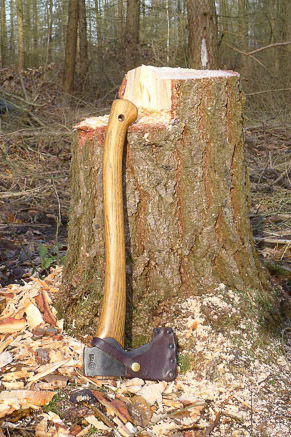
Whether your focus is carving, camping and camp craft, or wilderness expeditions, much of bushcraft – and specifically woodcraft – is made more viable through the use of an axe.
By employing an axe, laborious and time consuming jobs are completed much more quickly. Other techniques that were not possible with smaller cutting tools, become possible, which in turn provide access to a wider range of materials.
In short, having and using an axe in woodland and forest environments makes you much more efficient and much more effective.
That said, while many people are happy to pick up a knife and use it, fewer people are naturally confident with an axe.
There is a good reason for this. It should be fairly obvious to most right-thinking people that axes are more dangerous than knives.
Specifically, the added weight and leverage an axe provides over smaller cutting tools means any injury has the potential to be more severe.
Axe Safety And Efficiency
Safe practice with axes needs to be engrained from the start.
All the axe techniques you learn and employ should not only be safe, they should also be efficient.
Axes are not without weight. The head of an axe needs weight to work effectively. This means carrying an axe with you has the downside of it adding to the weight of your equipment.
If you use the axe efficiently, however, it will more than earn its place in your kit.
In and of itself, an axe will make many jobs easier. But you should also learn to use the axe efficiently and in a way that works with your body mechanics.
This is an area many people who already use an axe could improve their use of an axe. You’ll use less energy so you can do the same work without getting as tired or you can do more. This is beneficial in itself but also means you’ll be safer when using the axe over an extended period of time.
As well as short term energy efficiency, there are longer term benefits from good axe technique. For example, using ambidextrous techniques when sectioning logs, you will put much less strain on your back, which means less wear and tear over time.
The axe is one of the most important cutting tools for outdoor life and this course is built around learning to make the most of this versatile and valuable tool.
Axe Technique In Context
On this course we are not just teaching a string of techniques for technique’s sake. We also share with you and give you the opportunity to apply a wide range of camp craft, woodcraft and carving techniques in context.
The course is set in a traditional Sussex working woodland that has a wide range of natural resources available to us. As well as heading out into the woods to harvest the materials you need for various projects, you will be building out your camp, furnishing it with useful items and camp furniture and cooking tasty meals over campfires, all using the techniques we’ll show you.
For pretty much every job, you’ll see how much of an asset an axe can be…
Highlights Of The Woodcrafter Course
Selecting The Correct Tools For The Job:
There are many types of axe. Some are multi-purpose, some are specialist. We have a range of different axes that we will discuss and you will have the opportunity to use during the course. You’ll learn the strengths and weaknesses of each type as well as correct technique. We’ll also look at accompanying tools, from saws to froes to crooked knives. We’ll even be making some improvised tools.
Caring For Your Tools:
Looking after your tools is important. From sharpening axes properly to keeping wooden handles in the best condition, you’ll learn all the tricks to keep all your woodcraft tools in top order. We’ll also show you a few things you can carry with you on trips to keep your tools performing while on trips.
Everyday Axe Techniques:
An axe makes everyday jobs such as splitting firewood fast and efficient. But once we move away from the back yard, we need to learn to undertake these everyday tasks in a flexible way. No two campsites are ever the same so we must have a range of techniques that allow us to complete everyday tasks under different circumstances – with short chopping blocks, no chopping blocks, on rock, on soft surfaces such as snow and so on and so forth. And of course we must do this safely. It’s our aim to arm you with a toolbox of techniques which will serve you well wherever you and your axe may wander.
Felling, Limbing and Sectioning:
We mentioned that an axe can cause injury directly but an axe can also cause injury – or even death – indirectly. One of the most dangerous activities we can undertake in bushcraft is felling trees. There are various things which can go awry and we need to pre-empt these and mitigate the risks. Felling is not something to be afraid of but it should be undertaken with a good understanding of trees, the mechanics of felling and the dynamics of an unstable and then falling tree. We will show you how to assess whether any felling will be simple or complicated, to assess which way a tree will fall, how to make a felling site safe, good felling technique and how to solve some common problems. Once the tree is down we’ll then show you how to remove branches – limbing or snedding – efficiently and safely, as well as various useful techniques for sectioning the tree into logs.
Carving Techniques:
The ability to manufacture useful implements from wood is a valuable one. Further, being able to produce aesthetically pleasing items turns a utilitarian task into an appealing pastime. Good technique is at the heart of both these aspects of carving. From choosing the raw materials to splitting or carving out the section you need to hand positioning, body positioning and efficient body mechanics to visualising and realising your carving, we’ll share with you all the skills necessary to be producing useful and attractive items, which you will have ample opportunity to do during the course.
Classic Campcraft:
There’s a raft of camp craft skills which will turn your camp into a comfortable, organised base in which you can live and from which you can operate. From knots, hitches and lashings, throwing and tensioning ropes to pot hangers, cranes and tripods, to constructing camp furniture from natural materials, we’ll show you a wide range of techniques which can be applied and adapted in various combinations. Many of these techniques we use ourselves regularly when setting up base camps for courses or setting up group camps on expeditions.
Campfire Cookery:
A campfire always becomes the heart of every camp that has one. And once you have a campfire, some basic camp cookware and the ability to manufacture ways of suspending pots, creating grills and making camp ovens, your cooking options are huge. Throughout the week, we’ll introduce recipes and methods of turning out delicious and satisfying meals.
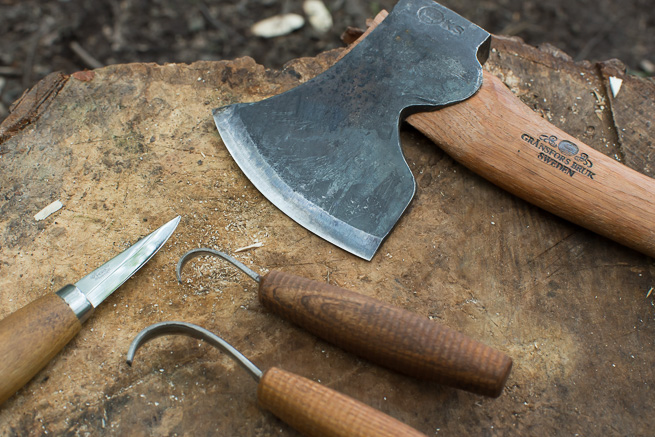
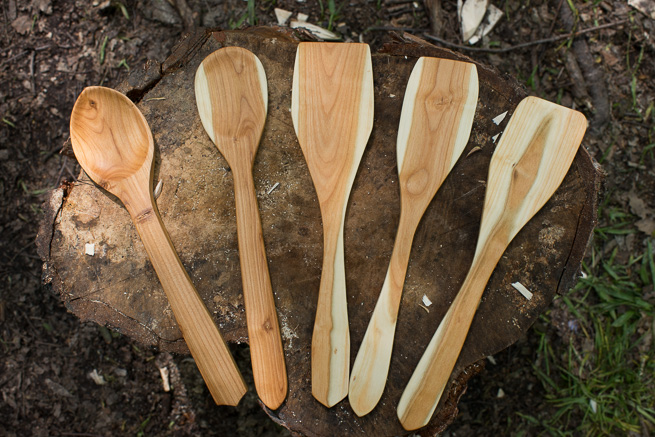

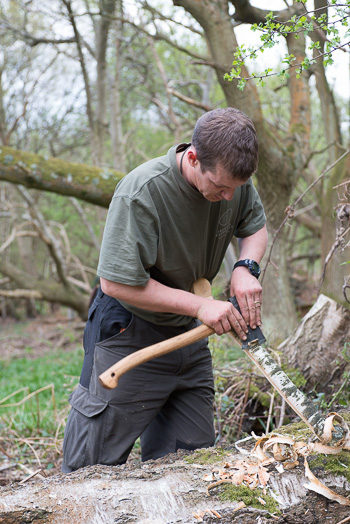
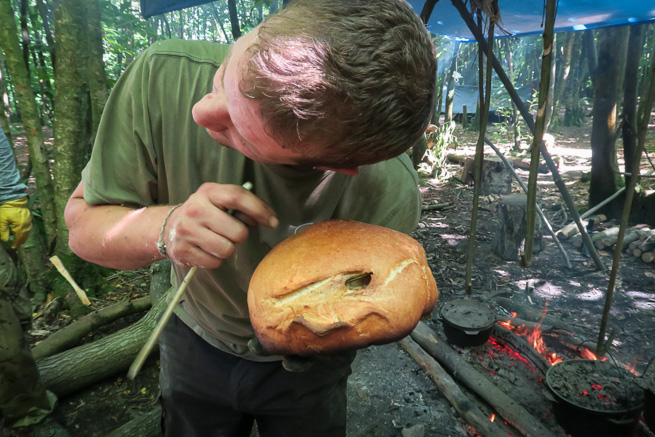
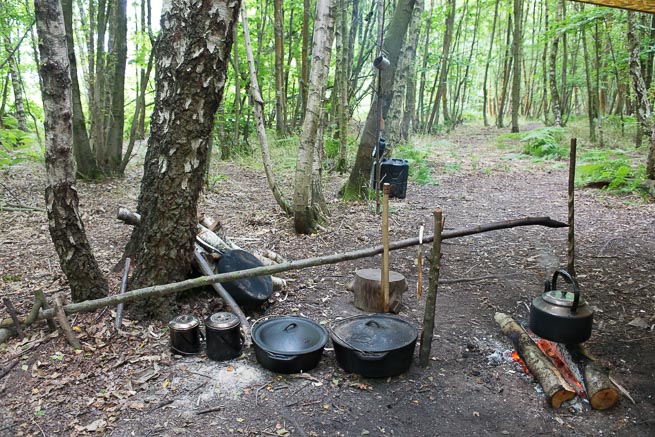
What People Say About The Woodcrafter Course:
“Safe axe use was the main element of the course for me, and I am quite satisfied that all necessary aspects of that topic were explained, with time to consolidate new skills over the week, as well as the chance to use many other tools and techniques. The course was conducted in a stunning part of the country, with helpful guidance at hand at all times. I work long hours and the course, as for most people, was taken as part of my annual holiday. I realised as I was driving home that I had not given work a thought all week, so even though the course was occasionally, physically demanding, I could not have had a more mentally relaxing week. I think I was in the middle of the spectrum of the course attendees, some of whom already owned a number of axes, and some of whom were more tentative about the course. Nonetheless, having spoken to each of them, I am certain that they had a great time and learned a lot, as did I. On that basis, I would have no hesitation in recommending this course to absolutely anyone who might be considering attending. Learning the skills I was seeking was the principal reason for attending the course; however, the food was great, the company superb and I was in the woods for a week. What’s not to like? Thanks again, Paul and Stuart, for a great break.”
Martin Pope, Bedfordshire.
“Before this course I was a little worried about the safety of using an axe. However this worry was dispelled by the emphasis placed on safety by the instructors, and the good example they set in handling the tools. The main thing I gained was more skill and confidence in the use of knife, which I had used before, and axe, which was completely new to me. In particular I got great satisfaction from learning to handle the small forest axe. Additionally the course gave me increased confidence in the woods, more experience of campfire cooking and the little bits of extra off-syllabus practical advice on seemingly small things, such as how to stay warm in my sleeping bag on a cold night. That little bit of advice transformed the experience of sleeping out. I would recommend this course, and Frontier Bushcraft in general, without reservation, because the tuition is excellent, and there is no ego or hard sell involved. “
John Clarke, Co. Wicklow, Ireland.
Detail of What You Will Learn: The Syllabus
- Understanding different types of axe
- Choosing an axe that is fit for purpose
- Making an improvised bow saw
- Making an improvised buck saw
- Understanding types of saw blade
- How to spot a dangerous axe
- How to care for your axe
- How to sharpen an axe
- Carrying and transporting axes safely
- Firewood splitting – fundamental techniques
- Optimal use of a chopping block
- Splitting firewood when you have no block
- Splitting firewood when you are on soft surfaces such as snow
- Efficient pole cutting
- Felling larger trees with axe and saw
- Efficient limbing of felled trees
- Sectioning of trees with axe and saw
- Splitting larger diameter logs
- Splitting long logs
- Proper use of splitting wedges
- Making gluts
- One-handed axe use
- Two-handed axe technique
- Ambidextrous axe use with smooth transitions
- Carving techniques for a general purpose axe
- Use of specialist carving axes
- Carving useful implements such as serving spoons, ladles, spatulas and cups
- Making field expedient chopping boards
- Making feathersticks with an axe
- Classic adjustable pot-hanger designs
- Larger pot hangers, tripods and cranes
- Camp grills – metal and green stick
- Fire lays and arrangements for efficient and effective cooking
- Dutch oven cooking, from baking to casseroles to roasts
- Improvised candle lanterns
- Producing quick and easy clothes pegs and coat hangers
- Making camp furniture
- Production of highly effective tent pegs for larger structures
- Pitching larger tarps
- Tensioning a rope using mechanical advantage
- Application of useful camp knots such as sheet bend, jam knot, waggoners hitch and buntline hitch
- Lashings with rope and wire
- Throwing a rope
- Hoisting techniques
- Keeping food out of reach of wildlife
All the Other Details You Need to Know…
Equipment
All specialist tools are provided for use during the course, including axes, saws and various splitting and carving tools.
A full kit-list is available here. The kit-list will also be e-mailed to you after your booking has been accepted.
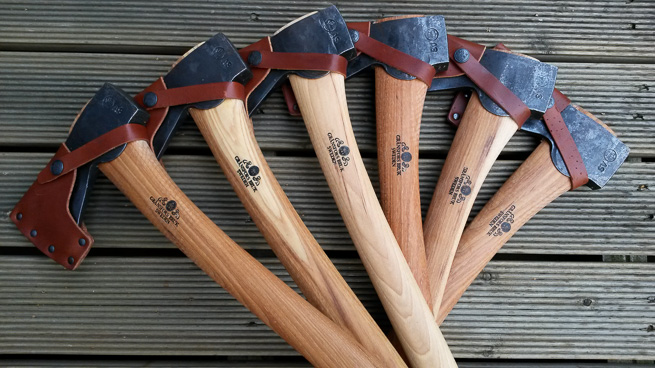
Accommodation and Venue
This course will be entirely outdoors, run from an expedition-style base-camp. Please bring personal camping equipment as per the course kit list.
Food
All food is provided. Equipment for cooking will be provided for use during the course.
If you have special dietary requirements there is the opportunity to tell us about this during the booking process. You can also pick up the phone to talk with one of our team about any concerns you might have.
Experience Required
You do not need to have previous experience of bushcraft or camping to attend this course but some knowledge of basic knife safety and simple knife techniques would be useful. The course will teach you the skills you need.
Availability and Booking: Woodcrafter
Duration: 6 days
Price: £797.
Deposit: 25% on booking.
Suitability: 18 years & above.
Course size: 12 participants (maximum).
Location: East Sussex.
Course Meeting Time: 18:30 Day 1.
Course Finish Time: 16:00 Day 7.
Course Leaders: Paul Kirtley and Iain Gair.
Woodcrafter Course Dates:
21/04/24 – 27/04/24 FULLY BOOKED
Back up to the bushcraft courses page.
